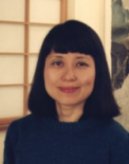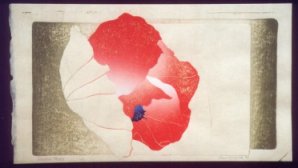Dedicated to the Art
and Artists
of Relief Printmaking
15685 SW 116th Avenue
PMB 202
King City, OR 97224-2695
Phone: 503-641-3555
FAX: 503-641-3591
Orders: 800-832-4264
www.imcclains.com
Go to McClain's On-line Catalog
Request a catalog
[ Cancel Subscription ] |
November 2005
Dear Friends,
For our artist profile this month, we corresponded with Daniel Heyman. He is an artist, teacher, and author currently teaching at both the Rhode Island School of Design and the Tyler School of Art in Philadelphia. He has exhibited prints and paintings extensively on the east coast of the US and abroad. In September, he served on a panel of Moku Hanga Printmakers at the Impact/Kontakt International Printmaking Conference in Berlin, Germany and Poznan, Poland. |
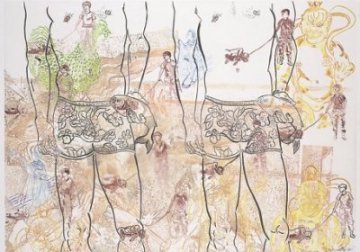
"Untitled" from War Series, Oil on Mylar, 33" x 42", 2004 |
McClain's:
How were you introduced to Moku Hanga (Japanese style printmaking)?
Daniel Heyman:
I wanted to go to Japan to learn about Japanese printmaking. I didn't know what Moku Hanga was and was really quite ignorant about the technique. I was simply in love with Japanese aesthetics -- the prints of course, but also the handmade papers. I was accepted as a resident artist at the Nagasawa Art Park Printmaking Program on Awajishima Island for the fall of 2002. Nagasawa is a program that invites mid-career artists who do not know Moku Hanga techniques to study with Japanese master carvers, printers, artists, and paper makers. I studied at Nagasawa for 9 weeks, and was in Japan a total of 4 months. |
McClain's:
Tell us a little bit about your experience as a panelist at the Impact/Kontakt Conference in Germany and Poland. What was going on there?
Daniel Heyman:
I was on a panel of artists all of whom had been to the Nagasawa program. |
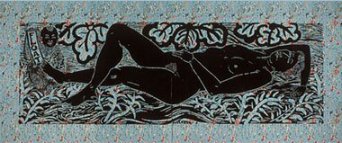
"Float", Linoleum cut, 78.5" x 43", 2003 |
Rebecca Salter gave a talk about traditional printed signatures left at temples, which was very very interesting. Each artist then spoke of their own work, and how their time in Japan and the techniques they learned there influenced their work when they returned to their home country. Several of the artists consider themselves printmakers, and then there were several, like myself, who love making prints, but know that printmaking, and being a master printer is not what they are. It was very interesting. Afterwards, we were able to show our printed work in a portfolio review session.
What made the conference so exciting for me, is that as a group, the Nagasawa artists come from many different countries, and it was exciting to connect with these artists and have a real exchange of ideas and inspiration.
One other high point was a lecture given by Thomas Kilpper, a German artist, who has used wooden floors of abandoned buildings as his matrixes, and has carved and printed these floors into immense woodblock prints. This for me was a revelation. |
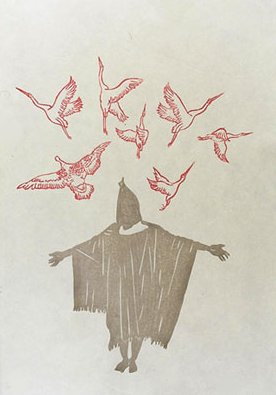
"Untitled" from War Series, Watercolor Woodblock Print, 2005 |
McClain's:
Do you encourage your students to think politically? What do you show them for inspiration?
Daniel Heyman:
I try not to push my students in terms of what the content of their art should be. Art making is a very personal affair, and the reasons one needs to make art are as various as there are artists. I do push my students to try to be aware of the world around them, and encourage them to read, go to films, see as many exhibitions as possible and to think about where their art might fit in to a larger context than simply themselves. As for inspiration? Another good question.... I always talk a lot about movie directors Almodovar, Kieslovsky, Kurosowa, among others. For printmakers I always talk about Munakata Shiko, Xu Bing, Nancy Spero, Chuck Close, David Hockney. Thomas Kilpper... then more generally, Kiki Smith for sure, Matisse, Picasso, Rothenberg, Wojnarowicz, Bourgeois... it is difficult to say because I try to encourage students to look at artists whose work they personally might find inspiring. As such, I sometimes suggest artists whose work I personally don't like but who I think might help a student's development.
To continue reading this interview, please click here. |
______________________________________________________________________________________
TIPS______________________________________________________________________________
Registering papers with deckled edges
One of the advantages to using handmade paper for your prints is to utilize the beautiful deckled edges that are inherent to Washi. The uneven edges and corners can however present a problem when registering. Here are a few ways to keep your deckles and register them too. These methods are best used with kento registration. |
Method A: Cut a corner and a straight edge (fig. A) on each sheet of Washi with a knife. It is important to align them with the position of the Kento on the block. This allows you to keep most of the deckled edges while assuring you a sturdy corner and side to fit into the kento marks.
Method B: Adhere removable adhesive labels to the Washi as shown in fig. B. It is important to align them accurately with the carved Kento marks and not to remove them until printing of all the blocks are finished. |
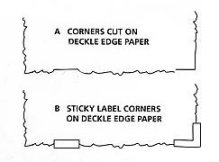 |
The straight edges of the labels will fit directly into the Kento marks, allowing for consistent registration time and time again, without having to cut into the Washi. If removable adhesive labels aren't available, it's a good idea to soften the adhesion of tackier labels first by sticking them on some cloth once or twice. This will help prevent the Washi fibers from pulling up during removal.
Source: Japanese Woodblock Printing by Rebecca Salter. See below. |
_______________________________________________________________________________________
LIBRARY________________________________________________________________________
Japanese Woodblock Printing
by Rebecca Salter
For the first time in almost 30 years, a full-length book has been written in English exclusively on Japanese woodblock printmaking. From a full history of the art form, a discussion of materials and their use and care, through a thorough description of methods and techniques, this book is full of infomation, tips and ideas for experienced printmakers and sound guidance for beginners. The author studied under Akira Kurosaki, a well-respected Moku Hanga printmaker and creator of the
Disk Baren. Full color illustrations throughout.
R2520 Japanese Woodblock Printing $19.95 |
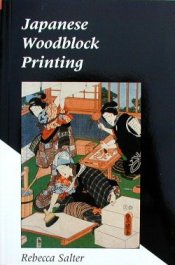 |
Japanese Woodcut Workshop Video, a course in four sections
by Izumi Kuroiwa
Think of this professionally made video as a week-long workshop, plus a refresher course you can watch any time you like. Watching a skilled artist actually create a print is what many of us need to understand a demanding art form like Moku Hanga. Ms. Kuroiwa is a master of her craft and her love and quiet enthusiasm for printmaking is contagious. As a teaching aid, an introductory lesson, or a refresher course for more experienced printers, this video is invaluable. 75 minutes are divided into 4 segments: 1) A Brief History, 2) Tools and Materials, 3) The Process of Japanese Woodblock Printmaking, and 4) Maintenance of Tools and Making Ink. A full transcription accompanies the video. Both the Video/DVD are in English. The DVD version includes bookmarked chapters for quick searching.
SALE!
R2500 VHS Video, regular price $80.00, Now $69.95
R2501 DVD, $80.00 |

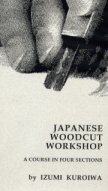
|
Moku Hanga Primer
by Robert McClain
Looking for a quick and concise approach to Moku Hanga? This description of Japanese woodblock printing materials, process, and techniques is direct and informative. It gives the basic information you need to try Moku Hanga or to refresh your memory of this style of printmaking. Mr. McClain, the company's founder, wrote and illustrated the book.
R2504 Moku Hanga Primer $8.50 |
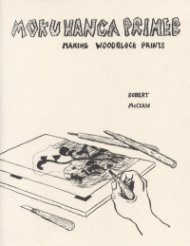
|
_______________________________________________________________________________________
PRODUCTS____________________________________________________________________
SALE! 4"x 6" Woodblocks
All-Shina, 5-Ply, and 3-Ply
Try out our woodblocks at a 10% discount! A handy size for smaller prints, these blocks are also perfectly sized for the Washi Cards listed below. |

From Top to bottom: 3-Ply, 5-Ply. All-Shina 4" x 6" woodblocks. |
SALE! Washi Cards
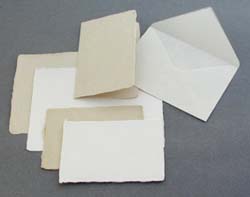
|
Handmade with 100% Kozo, these elegant cards are perfect for creating works of art to sell or send to your friends. The paper has four deckled edges and is sized so it will accept either water or oil based inks equally well. These cards are similar in weight to a very heavy card stock, while the envelopes are are made from lighter weight paper. The foldable cards come flat for easy printing. Score well before folding. Either the folded card or the postcard fit easily into the envelope.
The Light Natural cards are a soft ivory, while the Sea Grass cards are a cool, greenish color (See Pantone 4535). Offer good through December 2005. |
P7200 5 postcards, Light Natural 4x6, regular price $5.95, Now $5.35
P7201 5 postcards, Sea Grass 4x6, regular price $5.95, Now $5.35
P7202 5 foldable cards, Light Natural 6x8, regular price $9.50, Now $8.55
P7203 5 foldable cards, Sea Grass 6x8, regular price $9.50, Now $8.55
P7210 5 envelopes 4.5 x 6.5, regular price $7.75, Now $6.95 |
| NEWS___________________________________________________________________________ |
McClain's will be closing at 3:00pm on November 23rd and will be closed the 24th and 25th. Also, we'll be closed December 26th through the 30th to inventory products and to spend time with our families. Happy Holidays from Alex, Catherine, and Brandon!
|
| _____________________________________________________________________________________ |
|
|







